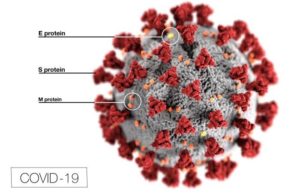This article is part of World War “V”: The COVID-19 Pandemic, a collection of all CNS COVID-19-related articles.
March 30, 2020 | Updated April 9, 2020
Webinar: Took place on March 25, 2020
Dr. Richard Pilch, director of the Biological and Chemical Weapons Nonproliferation Program, hosted a live webinar for the Spring Visiting Fellows, reviewing the status and response of the COVID-19 outbreak and the US response to it. He reviews what is known about how the virus works and reproduces, what it does to the body, and what makes it so particularly dangerous and contagious.
At the time of the webinar, there were 46,548 confirmed cases of COVID-19 in the United States, including 492 deaths. This number far surpasses those in the countries of the visiting fellows—Nigeria, Russia, Turkey, and Ukraine. Dr. Pilch describes the growing tension among U.S. authorities regarding the most appropriate path forward in the face of increasingly dire public health and economic outlooks.
Watch the webinar to learn about the measures to prevent and treat COVID-19 currently in development, including remdesivir, chloroquine, and experiments to take the antibodies developed in people who have had the virus (and survived) and infuse them in uninfected people as a preventative measure. The webinar also emphasizes the importance of social distancing and the need to maintain these measures in place; since the virus needs human cells to live, our efforts at stopping its spread require the continued practice of social distancing.
Presenter Clarifications
- R0
In the video, I describe the basic reproductive number (R0) of COVID-19 as approximately 2, meaning that on average, each COVID-19 case spreads the disease to two new cases. This is the best number we have based on available data; however, I failed to explain that the number varies by location and time depending on multiple factors, including contact rates and durations. For this reason, we monitor the “effective” reproductive number (now designated Rt, or reproductive number at time “t”) to determine how successful our countermeasures are over the course of an outbreak. For example, in Wuhan, reproductive number estimates ranged from well above 2 before the introduction of extreme social distancing and other mitigation measures to approaching 1 afterward (see, for example, https://www.thelancet.com/journals/laninf/article/PIIS1473-3099(20)30144-4/fulltext, and https://www.medrxiv.org/content/10.1101/2020.02.16.20023770v1). When R0 falls below 1, it signifies that countermeasures are working, and the disease is on the decline. We are carefully watching R0 in the U.S., most notably in New York City, to identify any similar trends. - Chloroquine
In the video, I state that chloroquine’s potential to treat COVID-19 is likely related to its ability to prevent the SARS-CoV-2 virus from entering cells. The reality is that chloroquine is not typically used to treat viruses, and we don’t have a clear understanding of its mechanism of action against them. Research has shown that chloroquine can raise endosomal pH, which suggests an ability to prohibit viral entry; however, it may be that chloroquine, or its analogue hydroxychloroquine, works by some other mechanism, for example by mediating inflammation. Since posting this lecture, a clinical trial published in the International Journal of Antimicrobial Agents found that hydroxychloroquine in combination with azithromycin reduced SARS-CoV-2 viral load and duration, albeit in a very small sample size. A pre-proof of the study can be found here: https://www.sciencedirect.com/science/article/pii/S0924857920300996
See Also
 World War “V”: The COVID-19 Pandemic
World War “V”: The COVID-19 Pandemic
A collection of all CNS COVID-19-related articles
